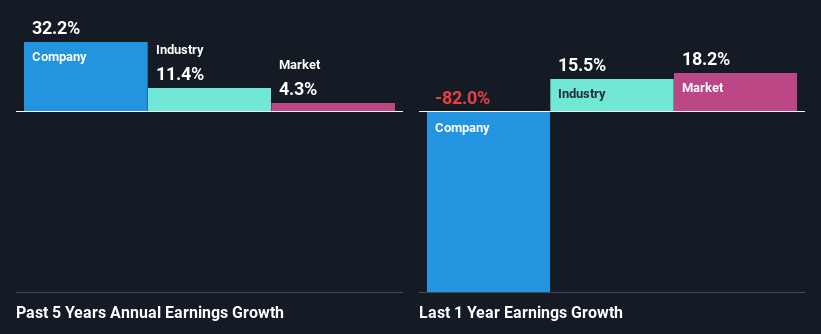Are NZ Windfarms Limited's (NZSE:NWF) Mixed Financials The Reason For Its Gloomy Performance on The Stock Market?
It is hard to get excited after looking at NZ Windfarms' (NZSE:NWF) recent performance, when its stock has declined 13% over the past three months. It is possible that the markets have ignored the company's differing financials and decided to lean-in to the negative sentiment. Stock prices are usually driven by a company’s financial performance over the long term, and therefore we decided to pay more attention to the company's financial performance. Particularly, we will be paying attention to NZ Windfarms' ROE today.
Return on equity or ROE is an important factor to be considered by a shareholder because it tells them how effectively their capital is being reinvested. In simpler terms, it measures the profitability of a company in relation to shareholder's equity.
View our latest analysis for NZ Windfarms
How Is ROE Calculated?
Return on equity can be calculated by using the formula:
Return on Equity = Net Profit (from continuing operations) ÷ Shareholders' Equity
So, based on the above formula, the ROE for NZ Windfarms is:
0.8% = NZ$312k ÷ NZ$38m (Based on the trailing twelve months to June 2021).
The 'return' is the amount earned after tax over the last twelve months. One way to conceptualize this is that for each NZ$1 of shareholders' capital it has, the company made NZ$0.01 in profit.
What Is The Relationship Between ROE And Earnings Growth?
We have already established that ROE serves as an efficient profit-generating gauge for a company's future earnings. Based on how much of its profits the company chooses to reinvest or "retain", we are then able to evaluate a company's future ability to generate profits. Generally speaking, other things being equal, firms with a high return on equity and profit retention, have a higher growth rate than firms that don’t share these attributes.
A Side By Side comparison of NZ Windfarms' Earnings Growth And 0.8% ROE
As you can see, NZ Windfarms' ROE looks pretty weak. An industry comparison shows that the company's ROE is not much different from the industry average of 0.8% either. Moreover, we are quite pleased to see that NZ Windfarms' net income grew significantly at a rate of 32% over the last five years. Considering the low ROE, it is quite possible that there might also be some other aspects that are positively influencing the company's earnings growth. For instance, the company has a low payout ratio or is being managed efficiently.
We then compared NZ Windfarms' net income growth with the industry and we're pleased to see that the company's growth figure is higher when compared with the industry which has a growth rate of 11% in the same period.
The basis for attaching value to a company is, to a great extent, tied to its earnings growth. It’s important for an investor to know whether the market has priced in the company's expected earnings growth (or decline). This then helps them determine if the stock is placed for a bright or bleak future. Is NZ Windfarms fairly valued compared to other companies? These 3 valuation measures might help you decide.
Is NZ Windfarms Efficiently Re-investing Its Profits?
NZ Windfarms has very a high three-year median payout ratio of 318% suggesting that the company's shareholders are getting paid from more than just the company's earnings. However, this hasn't hampered its ability to grow as we saw earlier. With that said, it could be worth keeping an eye on the high payout ratio as that's a huge risk. To know the 4 risks we have identified for NZ Windfarms visit our risks dashboard for free.
Additionally, NZ Windfarms has paid dividends over a period of four years which means that the company is pretty serious about sharing its profits with shareholders.
Conclusion
Overall, we have mixed feelings about NZ Windfarms. While no doubt its earnings growth is pretty substantial, its ROE and earnings retention is quite poor. So while the company has managed to grow its earnings in spite of this, we are unconvinced if this growth could extend, especially during troubled times. Until now, we have only just grazed the surface of the company's past performance by looking at the company's fundamentals. So it may be worth checking this free detailed graph of NZ Windfarms' past earnings, as well as revenue and cash flows to get a deeper insight into the company's performance.
This article by Simply Wall St is general in nature. We provide commentary based on historical data and analyst forecasts only using an unbiased methodology and our articles are not intended to be financial advice. It does not constitute a recommendation to buy or sell any stock, and does not take account of your objectives, or your financial situation. We aim to bring you long-term focused analysis driven by fundamental data. Note that our analysis may not factor in the latest price-sensitive company announcements or qualitative material. Simply Wall St has no position in any stocks mentioned.
Have feedback on this article? Concerned about the content? Get in touch with us directly. Alternatively, email editorial-team (at) simplywallst.com.

 Yahoo Finance
Yahoo Finance 
